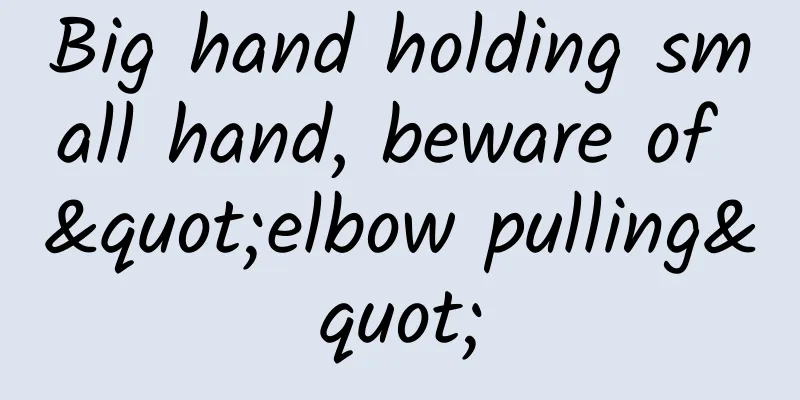Big hand holding small hand, beware of "elbow pulling"

|
1. What is “pulled elbow”? "Stretched elbow", also known as "elbow dislocation", "elbow dislocation", is clinically called radial head subluxation. It often occurs in children under 5 years old. Because the radial head of children is underdeveloped, the annular ligament surrounding the radial head is relatively weak. The main function of the annular ligament is to limit the range of motion of the radial head so that it will not dislocate. When the elbow is pulled in the extended position, the radial head is stuck and cannot return to the normal anatomical position, resulting in radial head subluxation. 2. Under what circumstances is "pulled elbow" likely to occur? 1. Pulling the child's wrist hard when going up the stairs or falling when walking fast while holding the child's wrist 2. Hold your child’s arm to swing or pull your child’s arm to spin in circles 3. Pull the child's upper limbs when dressing the child 3. What are the symptoms of “pulled elbow”? After radial head subluxation, the child will usually cry and make a fuss. The arm on the dislocated side will hang down weakly, and the child will not dare to move or touch the arm. There will be obvious tenderness on the outside of the elbow. Some children cannot clearly describe the symptoms, but they will refuse to use or move the arm on the dislocated side. 4. How to treat “pulled elbow”? It is recommended that parents take their children to the nearest hospital's orthopedic department for treatment. Generally, X-ray examination is not required for traction elbow, but if the child's elbow cannot move due to a fall, and there is obvious local swelling or even deformity of the elbow, an X-ray examination is required to rule out fractures. Generally, manual reduction can be performed without anesthesia. The reduction method is as follows: the operator holds the child's wrist with one hand and supports the elbow with the other hand, presses the thumb on the radial head, flexes the elbow joint 90°, and gently pronates and supinates the forearm, repeats several times, and pushes around the bone with the thumb to reduce the reduction. The sign of successful reduction is a slight snap and normal elbow movement. After reduction, it is not necessary to fix it, but parents are warned not to pull the affected limb violently to avoid recurrence. |
<<: To help you with the college entrance examination, you need to pay attention to your diet
>>: If smart drugs really exist, would you dare to take them?
Recommend
What are the methods for women to maintain their ovaries?
The ovaries are the reproductive organs of female...
Why do women have a strange smell?
Female friends sometimes smell a strange odor on ...
What can I eat to treat gynecological inflammation?
Gynecological inflammation is a common physical d...
Effects of hysterectomy at age 50
A 50-year-old patient with uterus and ovaries had...
Why are pregnant women's underwear a little yellow?
Pregnant women need special protection. If any ab...
I found out I was pregnant after taking a photo.
If a woman has an X-ray during tooth extraction, ...
Will third degree cervical erosion affect fertility?
Generally speaking, cervical erosion will not aff...
What to do if your endocrine system is not in good condition
Endocrine imbalance is something that many of us ...
What if I can’t see anything during the ultrasound when I’m pregnant?
At the beginning of pregnancy, the fertilized egg...
Pink on urine paper when I don't have my period
Women's menstrual period is cyclical, general...
Can a cold cause early menstruation?
Menstruation can sometimes be affected by externa...
Will I feel sleepy during late pregnancy?
Pregnant women always feel very tired after pregn...
What to do if your uterus is too small
A small uterus has a certain impact on women'...
How to maintain the uterus after spontaneous abortion
Spontaneous abortion is the last thing every woma...
There is a lump in the breast that hurts
The breast is a very important part of the female...









